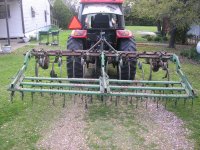Texasmark
Elite Member
- Joined
- Apr 24, 2012
- Messages
- 3,719
- Location
- N. Texas
- Tractor
- Ford: '88 3910 Series II, '80 3600, '65 3000; '07 6530C Branson with FEL, 2020 LS MT225S. Case-IH 395 and 895 with cab. All Diesels
The one thing I question about it was the motor size. Much smaller than the Mahindra and turning more rpm. It is difficult to find a torque chart on any of these tractors but I am thinking a larger motor turning less revs should equal more torque.
Engine HP is measured by a nasty equation that boils down to this simple fact: [Torque (ft-lbs) x RPMS]/5252 = brake HP. Older tractors were heavy and huge beasts turning low rpms. As technology improved torque was replaced by increased rpms allowing for a smaller package. This reduction in size fit well with designers of modern day small-medium tractors.
My 1960's era tractors operated at around 1000 rpm for the peak in the torque curve and PTO rated rpms were 1200, reverencing my 2000 Ford with the 4 cyl engine. A MF 35 I had with the Perkins 3 cyl diesel was 1000 for the peak. Haven't seen data on the rest I have owned over the years. My 6530 is 4 cyl like my 2000, peaks at 1600 and runs out to 2600 for rated 65 hp in an engine package about the size of the Ford delivering twice the HP.
The only time the 6530 was "technically challenged" was when I hooked this JD cultivator to it, which is left over from the days when I used it behind my 100 hp JD 4230, and initially failed to set my "draft" control and 3 pt. 3rd member length (setting the 10"sweeps pitch) correctly.

